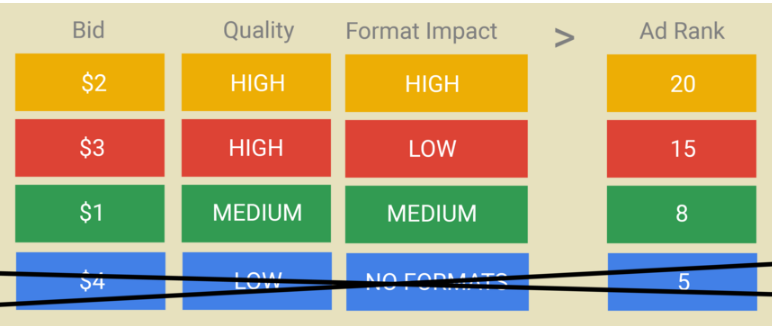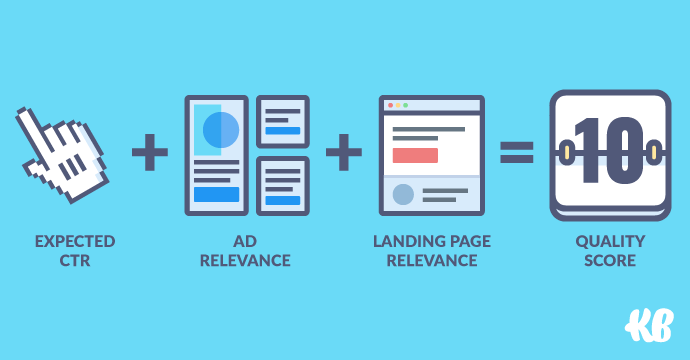By Sayan Mukherjee
Before we begin: The Fundamentals
Whether you’re an experienced AdWords professional, or someone just beginning to leverage the extremely feature-rich, yet complex platform that is Google AdWords, the fundamentals are extremely important in understanding how to write effective ad copy. The fundamentals begin by understanding how the Google AdWords backend; the Ad Auction; works, and about the relationship between how well your ad copy is structured with how much you’re bidding on your keywords.
Understanding the mysterious Google Ad Auction: Ad Rank & Bids
Why do I not get more clicks even though I’ve raised my bids? My ad copy looks great: it’s got offers, promotions, and blow-away offers but no one’s clicking on them! What do I do to make my ads more relevant?

If the above are some of the questions that you’ve been asking, then this section is right for you. Google calculates Ad Rank using a combination of your Bid, your Quality Score, and the impact of your Ad Extensions. Now, one has to understand how Quality Score is calculated.
Quality Score is one of the ingredients of the ‘secret sauce’ that the Google Ad Auction uses to rank the many, many ads that qualify for a particular auction, millions of times a second.

Image source: https://klientboost.com/ppc/quality-score/
Basically, Quality Score has three major components:
- Expected Click Through Rate or eCTR: Based upon the historical CTR of your ads, or for similar ads in similar auctions (remember, Google has data for billions upon billions of auctions). This takes into account how likely people are to click your ad.
- Ad Relevance: This is basically how relevant your ad is to the what the user is searching for, how many of your keywords match your ad text, and how many of the users search terms match with the keywords (and your ad text).
- Landing Page Experience: This is calculated using a complex mixture of factors including (but not limited to) how much time people spend on your website: do they leave immediately without spending much time at all (high bounce rate) or do they stay and explore (low bounce rate) among others. Is your landing page relevant to the ad you wrote (and therefore the keywords you used)? Among other things.
The Effect of Ad Extensions
Ad extensions are an extremely effective way to get high ad rank. Does your business have a phone number that users can call on? Use Call Extensions so that they can call directly by clicking (on mobile devices). Does your business have a brick and mortar store location? Then add a Location Extension so that nearby users can find you (and come to you). Similarly, there are a plethora of extensions that you can use to enhance your ads, and therefore improve your ad rank.
I won’t go into any more detail about extensions since that would be beyond the scope of the article, but do look them up to see which ones would be the best for your business. So, with that, we finally get into How to Write Amazing AdWords Ads.
Your Ad is What Your Customers See
This is almost a no-brainer, but we often miss the obvious. Keywords get you into the auction by getting matched to the users query, but all the customer sees is your ad. So writing compelling ad copy is one of the best ways to get your customers to click on your ad.
Differentiate yourself from the competition, highlight What Makes Your Business Unique. I’ve talked about this previously and I’ll say it again: position your brand, product or service in a way that makes customers want to visit your website.
Your Offers are What Make You Stand Out
Limited time discounts, unique content or promotions, special offers, basically anything that will make a customer want to visit your website to check out what you have that the competition doesn’t. Write ad copy that makes your customers want to check you out.
Keep testing out new Ad Copy to see what works best. It’s Google Best Practice to have at least three ads per ad group, so that you know what’s working and what’s not.
Call Your Customers to Take Action
Once again, I’ll be parroting the obvious, but in my 4+ years working for Google, I’ve come across literally thousands of ads that don’t have a call to action. What do you want your customers to do: buy, sign-up, download?
Make it clear and obvious in the ad, this will give the customer more information about the kind of action that they’re expected to take, and hence make the percentage of relevant clicks higher. An unclear ad often leads to non-relevant clicks, and since most billing is Cost Per Click, you’re paying for clicks that don’t benefit your business.
Include Your Keywords in Your Ads
As we’ve discussed in The Fundamentals above, having one or more of your keywords in your ad really, really helps in driving up your Ad Relevance and hence reducing costs by increasing Quality Score.
However, having your keywords in your ads also ensures that the user sees related (or often exact) terms to their own searches, thereby increasing the probability of their clicking through. This increases your Click Through Rate (CTR) and drives up your Quality Score, and reduces your cost.
Theme Your Ad Groups Tightly
Structure, structure, and structure: it’s almost a stricture. Pardon the pun, but tightly themed ad groups make for highly connected, related keywords that are talking to ads that contain those keywords. This in turn ensures that the users searches match to your keywords that again throw up ads that are closely related giving you a double benefit: high quality score and high CTR.
Match Your Ads to Your Landing Page
Just as your ads should talk to your keywords, so they should match to your landing page. A user looking for rose bouquets near me will probably bounce away if directed to a non-relevant page that has orchid bouquets, even if they’re on sale.
The Google Quality Score system is designed to provide the best experience to the user: in this case your customer, the person searching for goods and services that you’re offering. So to put it simply: your ads connect to your keywords and to your landing page
Mobile Mobile Mobile
A study reveals that 50% of users performing local searches on mobile end up visiting the physical stores. Be sure to include mobile relevant keywords in your ad text, along with mobile oriented extensions such as Call, Location and Message Extensions (yes, you can now have users message you directly, it’s awesome!).
Before You Go: Remember the Policies!
Wrapping everything up, please remember to keep in mind Google’s Ad Policy and guidelines so that you don’t run into Ad Disapprovals or Trademark Disapprovals and have your ads banned.
To have your polished, well-written, and jazzy ad being banned just because you didn’t apply for a trademark exception can cause immense frustration. So please remember to carefully read through the ones that apply to you and your business.
Now that you’re clear on the fundamentals, and familiar with the policies, good luck writing those amazing new ads that have your customers lining up to convert!
About Me

I’m Sayan, and I occasionally write for Indspire Me. I have an almost passionate penchant for wordplay, Dota, Age of Empires II, and marketing (and overusing the Oxford Comma). I’m an alumnus of the Delhi College of Engineering, and have worked in Google for over 4 years, so yeah I know some things about Google AdWords and Google Analytics.